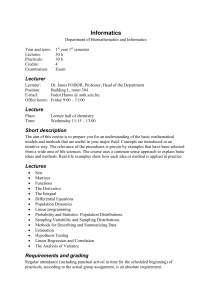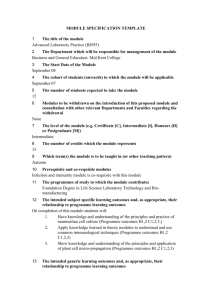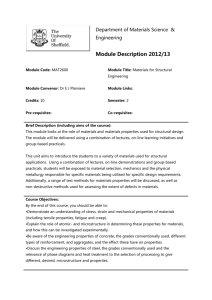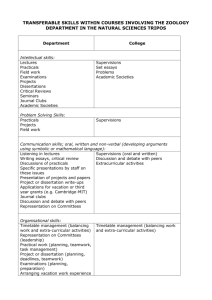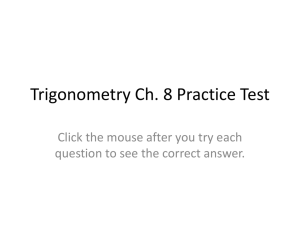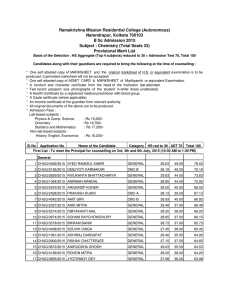My experiments with PER
advertisement
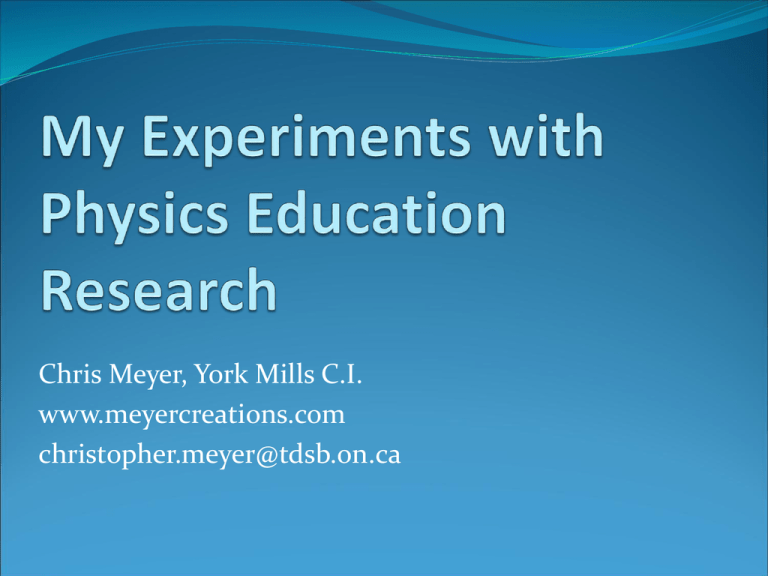
Chris Meyer, York Mills C.I. www.meyercreations.com christopher.meyer@tdsb.on.ca “The question, of course, is how well this experiment [his introductory course] has succeeded. My own point of view – which, however, does not seem to be shared by most of the people who worked with the students – is pessimistic. I don’t think I did very well by the students. When I look at the way the majority of the students handled the problems on the examinations, I think that the system is a failure. Of course, my friends point out to me that there were one or two dozen students who – very surprisingly – understood almost everything in all of the lectures, and who were quite active in working with the material and worrying about the main points in an excited and interested way. These people have now, I believe, a first-rate background in physics – and they are, after all, the ones I was trying to get at. But then, “The power of instruction is seldom of much efficacy except in those happy dispositions where it is almost superfluous.” (Gibbons)” Richard Feynmann, from the introduction to his set of lectures for the first year physics survey course (180 students) at Caltech. The Feynmann Lectures in Physics (pg. 5) Why change? In a traditional lecture, how many students do we engage? What proportion of class time do students spend wrestling with physics ideas? How much writing or talking do they do about physics in their own words? How much feedback do students get to guide their understanding of physics concepts? What have they learned to help them solve more than a plug’n’chug type problem? Physics Education Research Universities noticed poor results from traditional teaching practices Student understanding explored and quantitatively measured, and practices refined Variety of techniques developed (Redish, Teaching Physics with the Physics Suite) Quantified Success From: Redish, Teaching Physics with the Physics Suite The Social Learning Principle For most individuals, learning is most effectively carried out via social interactions MIT – Introductory Physics Implementations U of T Practicals Implementations Show me the goods! Sounds great - how to pull this off? Change! Teacher lecture Student group learning Cookbook activities / labs Guided-inquiry activities Content: broad and shallow Deep and focused Plug’n’chug problems Context-rich problem solving Furious note-taking Careful textbook reading Describing Explaining The good news: I have done most of this for you. Less is More Less content is covered, but in more depth Each idea explored from many angles Research shows having fewer, but solid, pillars of understanding in no way harms their education Question yourself - What is the purpose of racing through what they don’t understand? Target the Whole Class Traditional Teaching = Sputnik Model Find the best of the best fast and educate them as quickly as possible Reformed Teaching = Life Sciences Model An increasing number of disciplines need core physics knowledge and skills to prosper in 21st century From the Toronto Star “The trouble with biologists in the academic world is they are trained to work on their own,” says Edwards. “Ray, by contrast, was trained as an engineer to work in teams, to problem solve.” Group Work Structure the course around groups Provide explicit training in the good function and management of groups Provide opportunities for critical reflection of group work skills Devote energy to daily coaching of groups Get whiteboards Group Structure Size: 3 people, rarely 4 or 2 Gender: MMM, FFF, FFM, rarely MMF Group Roles: Manager, Recorder, Speaker Composition: a strong, medium and weak student Rotation: Groups change every major unit (3-4 weeks) Seating: Always face-to-face human human Table human Change Your Role Moderator and socratic “inquisitor” of group activities Facilitate class discussions Provide summaries, clarifications and tips Transform the Lessons Lectures are largely gone or are at most 10 minute intros Guided-inquiry activities - introduce and explore new ideas Problem solving challenges reinforce and apply concepts The Physics Challenge CGPS: The Scale Challenge! Do not write on this page! You will need: One incline, One retort stand, One test-tube clamp, One small object (m < 200 g) Brains Set up your incline at any angle between 25o and 40o. Your teacher will place a digital balance scale on your incline with your object resting on it. Predict the reading of the scale in grams. Show the results of your calculations before the test! Bonus How would your prediction change if the object and the scale were free to slide down the incline while making the reading? Redesign Homework Homework consists of: Textbook note-taking: extend or formalize understanding from the day’s activities Problems: a few well-chosen problems that further the understanding of concepts – limit the plug’n’chug A thing not worth doing is not worth doing well. Reassess the Evaluation Evaluation must reflect the goals of the new course. Evaluate: basic skills quality of physics writing and explanations understanding of concepts genuine problem solving The Measure of Success • Much greater student engagement across all mark ranges • 60 minutes of hard work per class • Emphasis on writing • Direct, face-to-face probing of student understanding How to Start? For the full set of Gr. 12 activities and teacher resources, go to: www.meyercreations.com Resources • The Physics Suite http://www2.physics.umd.edu/~redish/Book/ • Cooperative Group Problem Solving http://groups.physics.umn.edu/physed/Research/CGPS/Gree nBook.html • Workshop Physics http://physics.dickinson.edu/~wp_web/wp_homepage.html • Tutorials in Physics Sense-Making http://www2.physics.umd.edu/~elby/CCLI/index.html • U of T Practicals http://www.upscale.utoronto.ca/Practicals/ • Tutorials in Introductory Physics http://www.phys.washington.edu/groups/peg/tut.html How to Start? For the full set of class activities and teacher resources, go to: www.meyercreations.com Try out individual activities Try one whole unit Go all the way! Arrange a visit Need help? christopher.meyer@tdsb.on.ca
